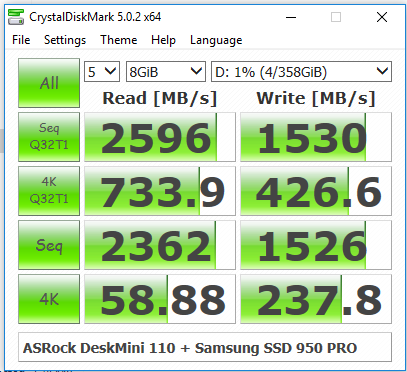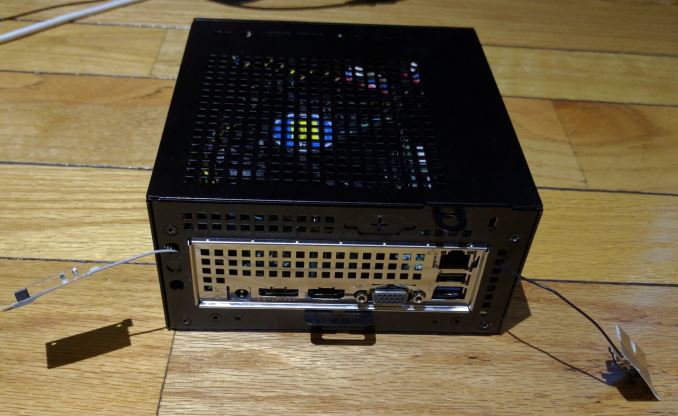ASRock DeskMini 110 mini-STX PC Review
by Ganesh T S on June 8, 2016 8:45 AM ESTNetworking and Storage Performance
Networking and storage are two major aspects which influence our experience with any computing system. This section presents results from our evaluation of these aspects in the ASRock DeskMini 110. On the storage side, one option would be repetition of our strenuous SSD review tests on the drive(s) in the PC. Fortunately, to avoid that overkill, PCMark 8 has a storage bench where certain common workloads such as loading games and document processing are replayed on the target drive. Results are presented in two forms, one being a benchmark number and the other, a bandwidth figure. We ran the PCMark 8 storage bench on selected PCs and the results are presented below.


Despite using the same SSD, we do see some difference in scores between Skull Canyon and the DeskMini. This probably results from differences in the CPU capabilities, since the storage bandwidth actually reflects the amount of time that the CPU was waiting on at least one I/O request to the disk.
The important aspect to test from the DeskMini viewpoint is PCIe 3.0 x4 support (since the H110 has only PCIe 2.0 support). We ran the quick CrystalDiskMark check and could see that the Samsung SSD 950 PRO showed its quoted performance numbers.
On the networking side, we restricted ourselves to the evaluation of the WLAN component. Our standard test router is the Netgear R7000 Nighthawk configured with both 2.4 GHz and 5 GHz networks. The router is placed approximately 20 ft. away, separated by a drywall (as in a typical US building). A wired client is connected to the R7000 and serves as one endpoint for iperf evaluation. The PC under test is made to connect to either the 5 GHz (preferred) or 2.4 GHz SSID and iperf tests are conducted for both TCP and UDP transfers. It is ensured that the PC under test is the only wireless client for the Netgear R7000. We evaluate total throughput for up to 32 simultaneous TCP connections using iperf and present the highest number in the graph below.

In the UDP case, we try to transfer data at the highest rate possible for which we get less than 1% packet loss.

Our main aim with the WLAN component was to show that the DeskMini could indeed support a M.2 PCIe WLAN module. Intel actually provided us with a AC8260 card meant for the Skull Canyon NUC. Therefore, the antenna type we got was really not a good fit for the all-metal chassis. We ended up doing the above evaluation with the antennae not mounted to the chassis, but just hanging out of the system. Despite this unwieldy setup, the system had no trouble getting good numbers in our bandwidth test.
The DeskMini chassis does provide three perforations diagonally across the M.2 WLAN slot in the rear to install screw-type antennas. Consumers can keep this in mind while hunting for the appropriate WLAN component to complete a DeskMini build.












85 Comments
View All Comments
Screwville512 - Monday, December 5, 2016 - link
Do you own it? I am interested in purchasing one and was wondering if you think its possible to modify the case to accept 15mm drives. Seagate now has 5TB 2.5" 15mm HDD's and I think those in RAID 1 would make the Deskmini a great portable NAS. Otherwise, I will go with 2tb SSHD in RAID 0 with an external backup drive.rgs84 - Wednesday, September 21, 2016 - link
Can someone confirm that I can use it for example with i5-6685R, same 1151 socket, but better video onboard (Iris Pro 588)?chrismart1234 - Thursday, September 22, 2016 - link
Nah; it supports full desktop processors only not mobile processors.wstkwon - Tuesday, January 3, 2017 - link
Hey, I tried to make this pc, but my monitor is blank. WTF? ANy hel please?n13L5 - Sunday, August 5, 2018 - link
Out of all the other systems, this particular system needs an AMD version the most - to put a 2400G APU in it...For my purposes of making a sub-$500 play computer for my daughter - the ASRock DeskMini 110 is over-speced in the wrong place and under-speced in the wrong place. With an Intel i5, it simply lacks an interesting niche. Any and every other box has a CPU+RAM+SSD, including much smaller things like NUCs etc - at this size, it should have an APU to be worth the bother.